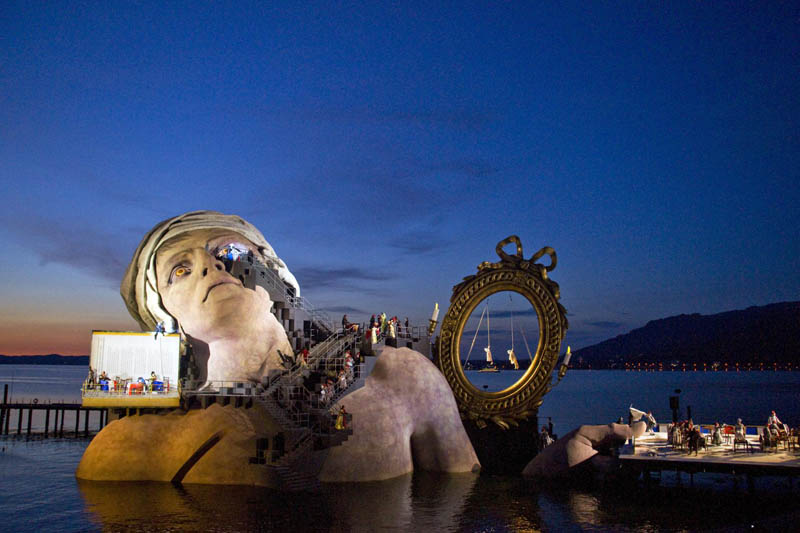
Since 1946, the Bregenz Festival ‘Opera on the Lake’ in Austria has
been home to some of the most incredible outdoor stages ever built. Set
on the gorgeous Lake Constance, the 6,800 capacity ‘Seebuhne’ Stage has
been the setting for some of the world’s most famous operas.
During the 2007 performance of Tosca, the producer and director for the James Bond film Quantum of Solace
were so impressed, they filmed a 10-day scene in Bregenz where Bond
meets his adversary for the first time during a performance of Tosca.
Below you will find a collection of the amazing outdoor stages
throughout the history of the Bregenz Festival, along with a detailed
timeline of key milestones and events and information on the challenges
of building an outdoor stage on the water.
2. La Bohème | 2001-2002

Photograph by KARL FORSTER
3. Aida by Giuseppe Verdi | 2009-2010
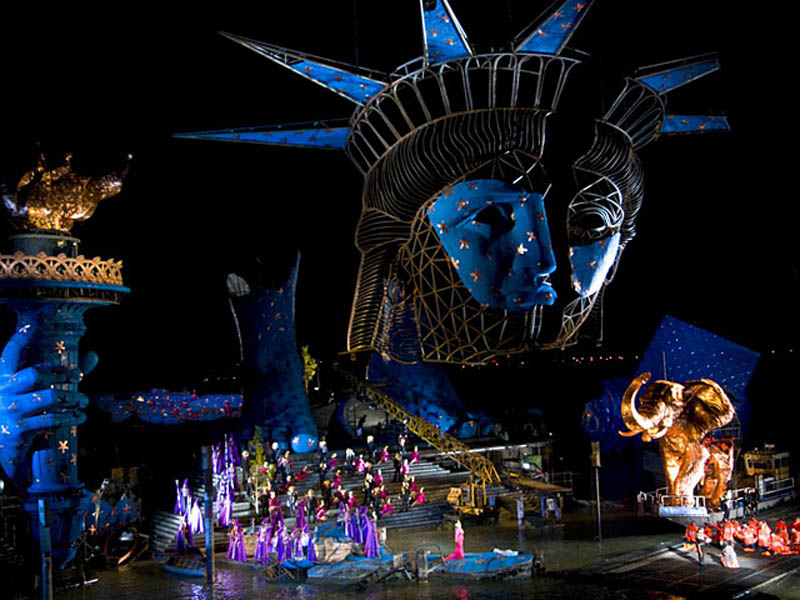
Photograph by Bregenzer Festspiele / andereart
4. A Masked Ball by Giuseppe Verdi | 1999-2000
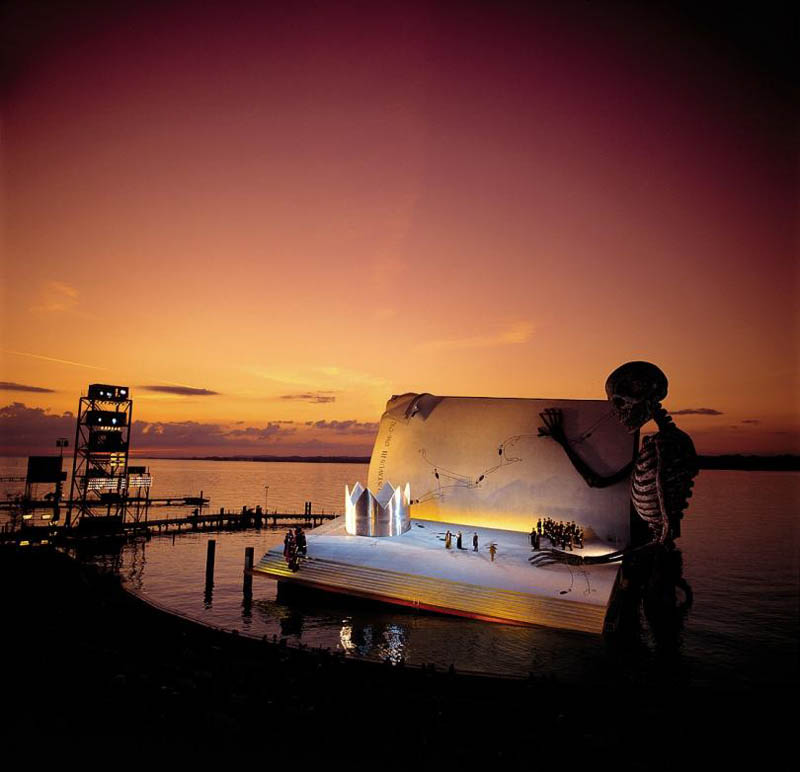
Photograph by BENNO HAGLEITNER
5. Carmen | 1991-1992
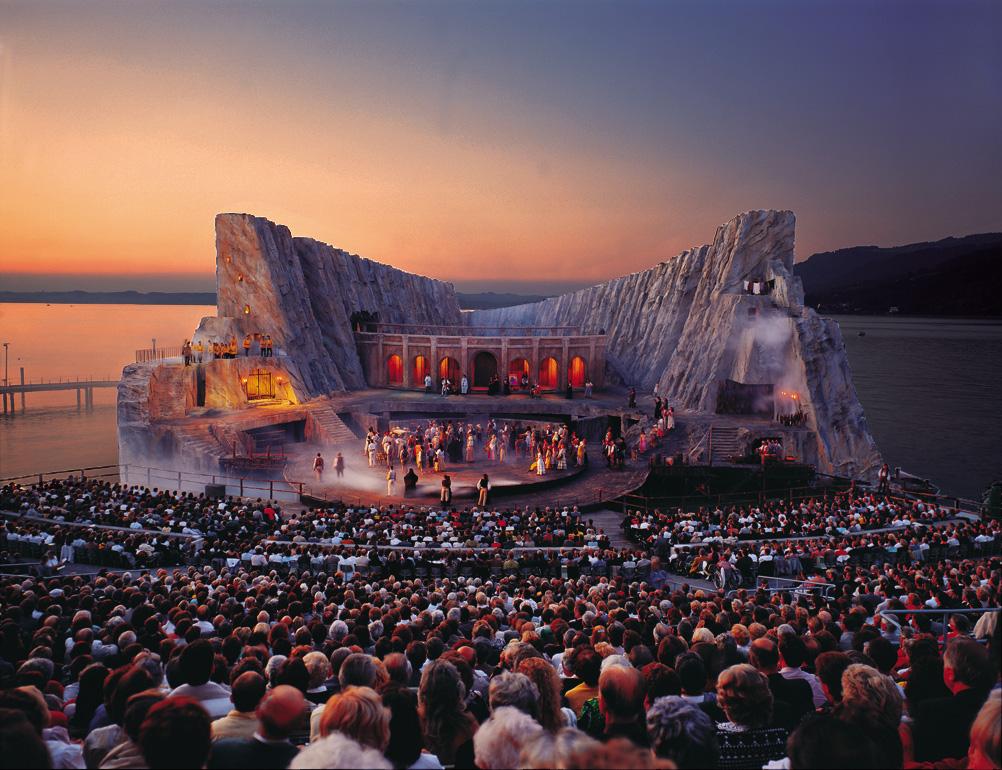
Photograph by KARL FORSTER
OPERA ON THE LAKE – THE FLOATING STAGE AT BREGENZ
- The opera stages are built every two years on a fixed structure called the ‘concrete core’, which is anchoed in Lake Constance
- It houses the costume & dressing rooms, the machine rooms and the orchestra pit for the Vienna Symphony Orchestra
- Wooden piles are driven into the bed of the lake to support any additional structures the stage set may require, however there are three basic requirements to the stage which must be met:
SIZE OF THE SET
- The floating stage must be two-thirds bigger than normal for it not to be ‘swallowed up’ by the natural surroundings
- It must also be visible from the back-rows of the 6,800 seat auditorium
- Must be built so changes to scenery can occur quickly and silently since there is no curtain
WEATHERPROOF
- The stage will be exposed to extreme weather during the two-year production runs: downpours, gales, thunderstorms, up to 50cm of snow and -20 Celsius weather
- Durable materials must be considered, as typical stage materials will not stand up to the elements
WEIGHT
- The set must weigh as little as possible. Too much concrete, brick and solid wood are weatherproof but too heavy for the concrete core the stage is set on
- Typically a sandwich construction of steel on the inside and wood on the outside is used
- While light-weight synthetic materials do exist, the stage itself must be disposed of in an environmentally-friendly way at the end of the second season
6. Tosca | 2007-2008
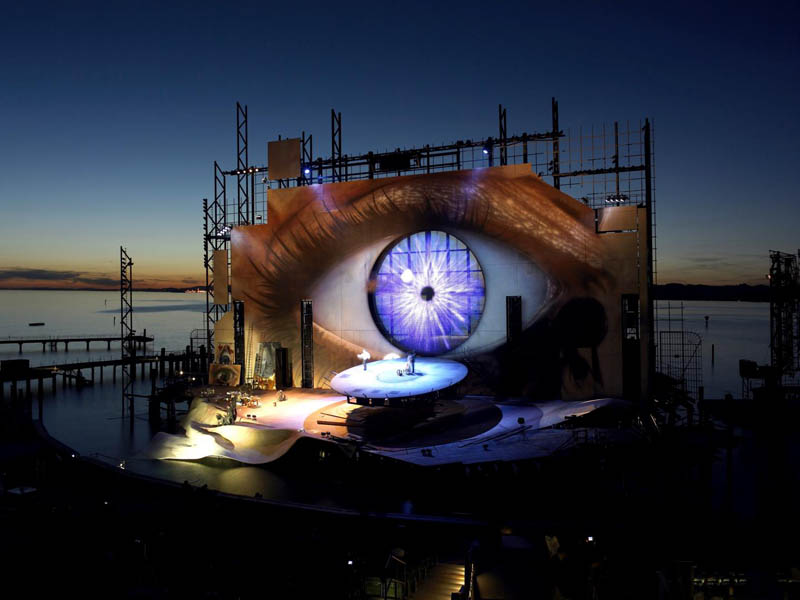
Photograph by BENNO HAGLEITNER
7. West Side Story by Leonard Bernstein | 2003-2004
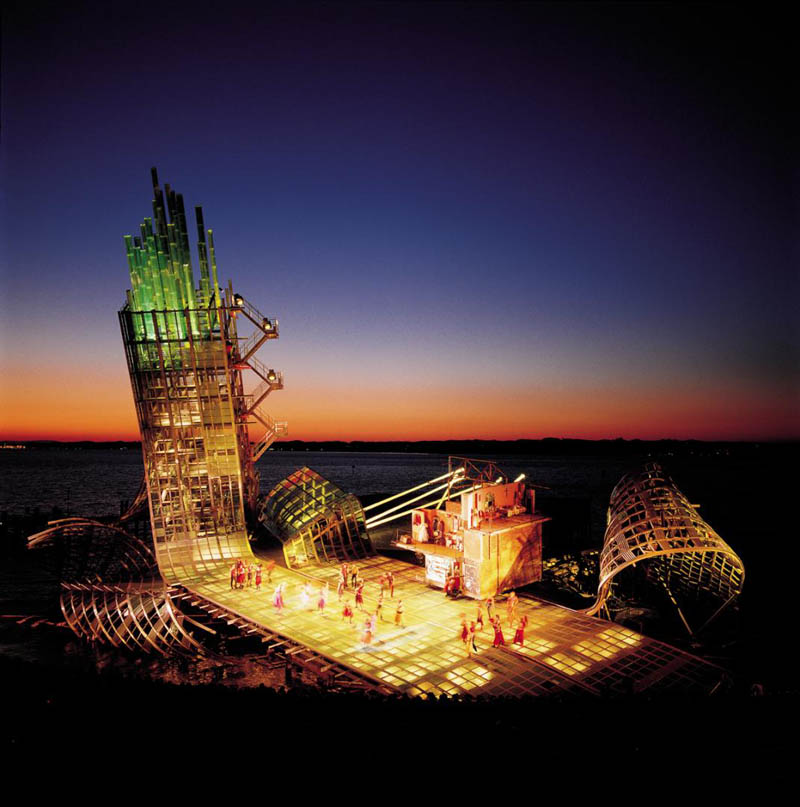
Photograph by BENNO HAGLEITNER / VISION fotografie
8. The Flying Dutchman | 1989-1990
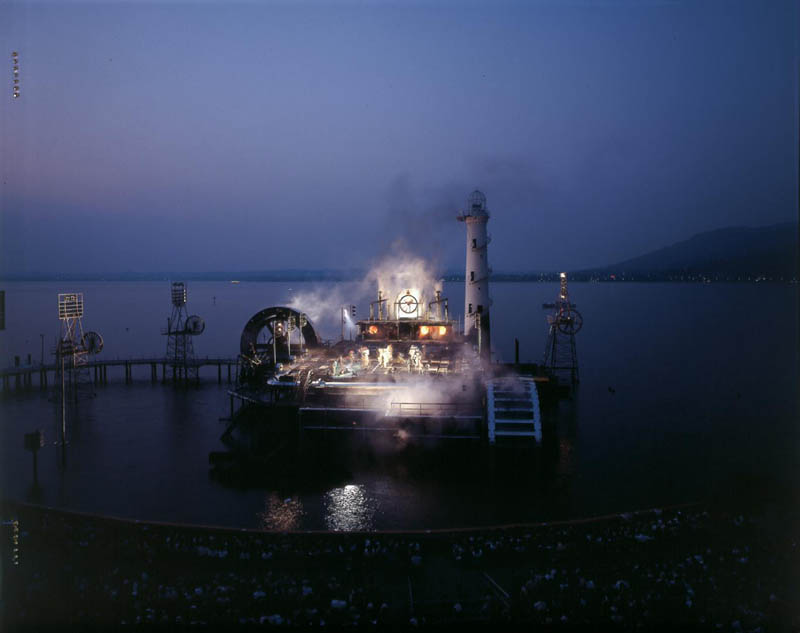
Photograph by KARL FORSTER
9. Nabucco | 1993-1994
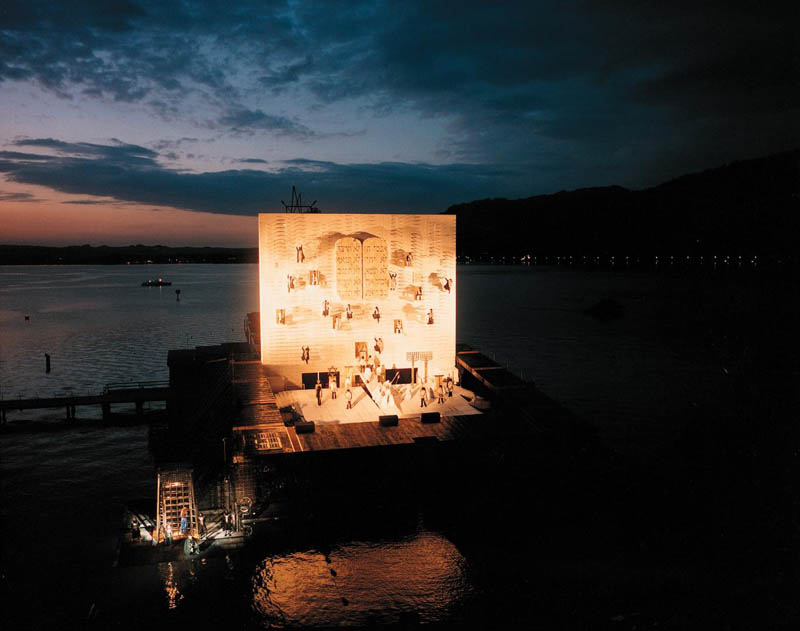
Photograph by KARL FORSTER
10. Die Zauberflote by Mozart | 1985-1986
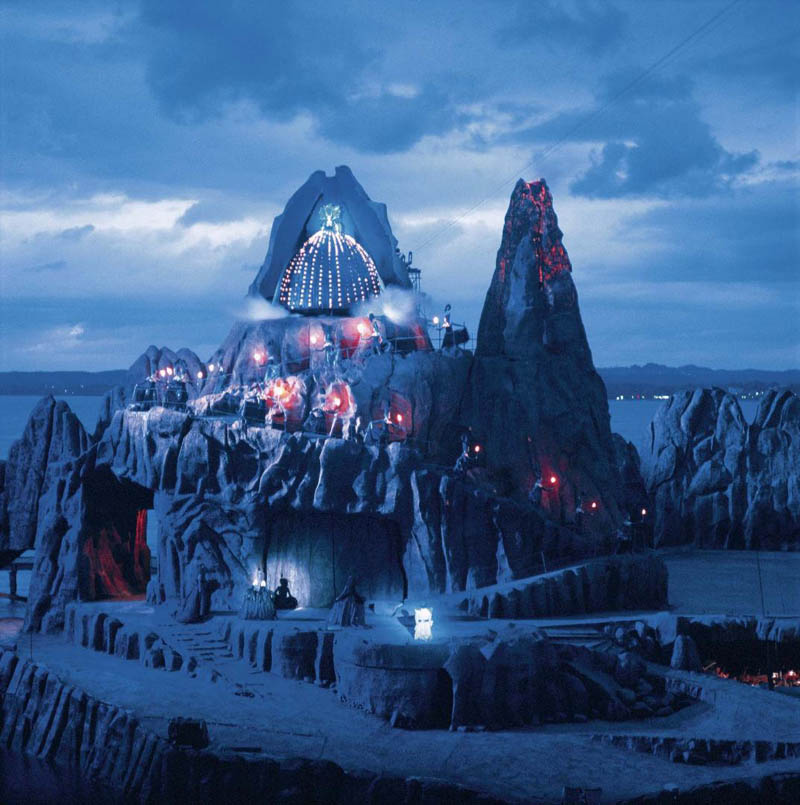
Photograph by KARL FORSTER
HISTORY OF THE BREGENZ FESTIVAL
1946: One year after the end of the Second World War, the first Bregenz Festival was held: the week-long Bregenz Festwoche. The inaugural performance was staged upon two barges moored on Lake Constance – one carrying the stage structures for Mozart’s early work Bastien et Bastienne, the other the orchestra. In a town that did not even possess a theatre, the idea of mounting a festival seemed eccentric; but the initially makeshift solution of choosing the loveliest part of the town – the lake – as the stage proved to be a hugely successful one. Visitors from Austria, Germany, Switzerland and France made the Festival an international event in its very first year. The Festival orchestra from the outset was the Vienna Symphony Orchestra, which has made a major contribution to the evolution and success of the Festival.
1950: The Bregenz Festival acquired its first home: an off-shore stage erected on wooden piles, on which mainly operettas and ballets were performed. The open-air auditorium had a capacity of 6,500 seats; in the event of rain, a sports’ hall seating 1,000 people could be used instead. The previous year, 1949, had seen the foundation of the Patrons of the Bregenz Festival, a Bregenz residents organization which subsequently became the organizer of the annual Festival.
Stage designer Walter von Hoesslin, with director Adolf Rott, took the first steps towards a distinct Bregenz production style, in that he dispensed with the conventional proscenium stage when designing the Seebühne. For him the lake was not just scenery, but a central element of the productions.
1962: Thanks to strong public interest, the Festival became longer each year and its programme became more varied. Starting in 1962 chamber music concerts and Haydn operas were performed in the Renaissance Palace at Hohenems. On the Lake, ballet evenings were staged from 1960 onwards and were a great success.
1985: A new era for the Festival was ushered in by the triumphant success of The Magic Flute on the Lake. From this year on, all productions on the Seebühne run for two seasons. The stage constructions became sturdier because they now had to stay put throughout winter too. The Bregenz directors aimed at a unique production style: namely popular theatre accessible to all and yet with high artistic standards. The Bregenz style stands for the bold visual representation of the themes in the operas on the Lake. This means the operas can be understood on an emotional level and are easier to comprehend, so that even people who rarely go to the opera can follow what is happening in the work. It is this production style, the unique location, and the inimitable atmosphere of open-air theatre which account for the special appeal of the Bregenz Festival.
11. Bastien and Basteienne | 1946
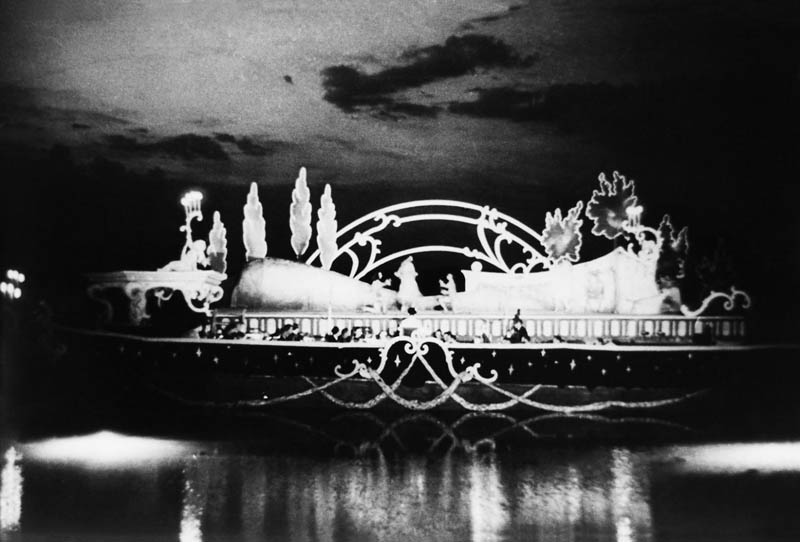
Photograph by Bregenzer Festspiele
12. The Tales of Hoffmann | 1987-1988
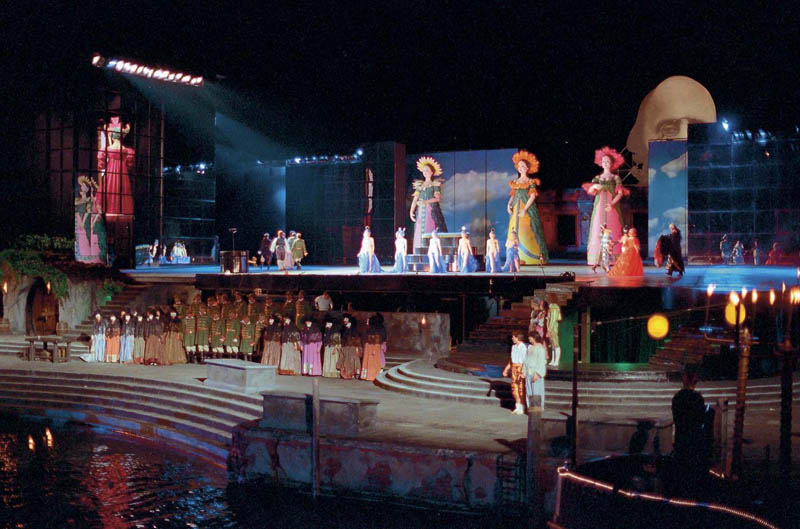
Photograph by KARL FORSTER
13. The Troubador | 2005-206
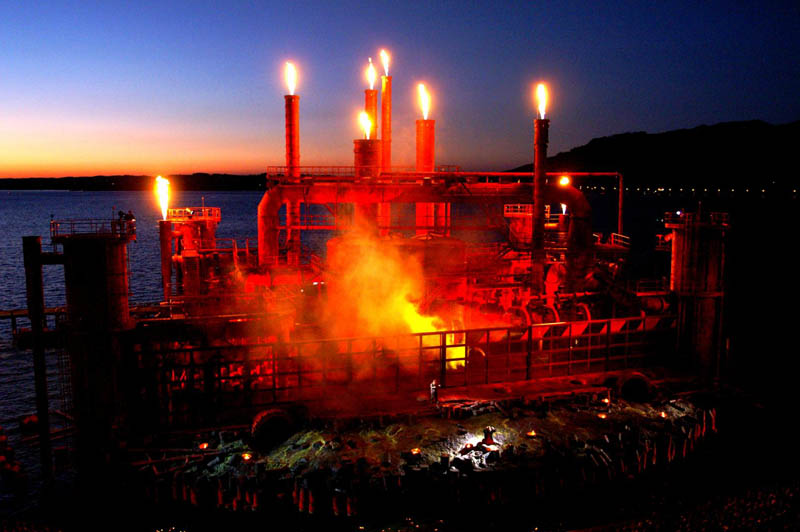
Photograph by KARL FORSTER
14. Fidelio | 1995-1996
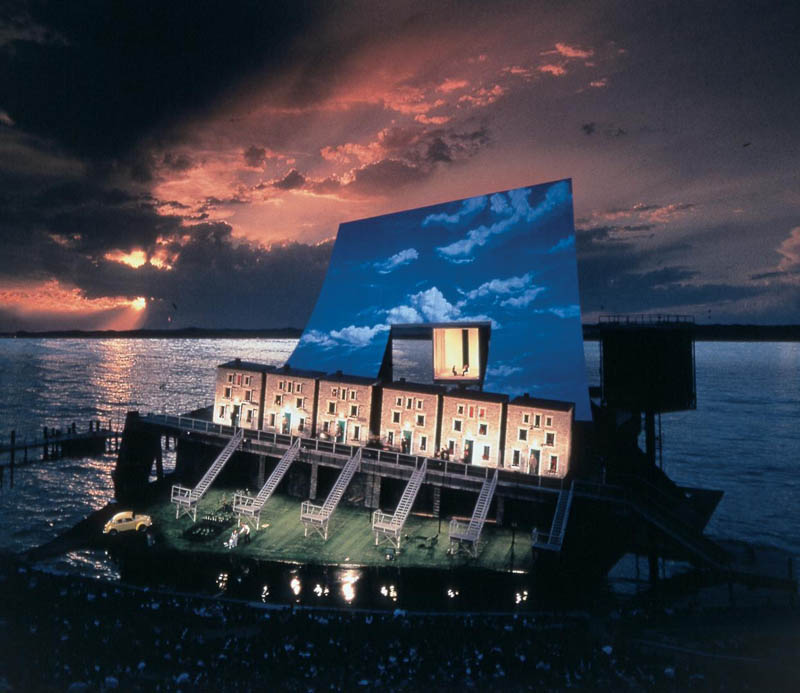
Photograph by KARL FORSTER
15. Adachi Museum of Art – Yasugi, Japan
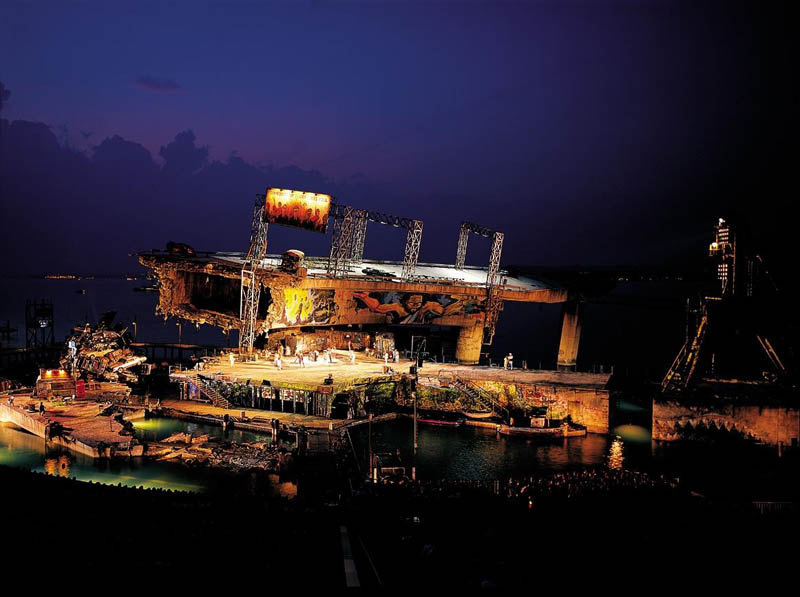
Photograph by KARL FORSTER
HISTORY OF THE BREGENZ FESTIVAL Continued…
1993 und 1994: Public interest in the Seebühne production of Nabucco exceeded all expectations; additional viewing stands were erected and extra performances were scheduled, but still the demand could not be fully satisfied. Over 300,000 people saw Verdi’s Nabucco on the Lake in the summer of ’93 and ’94. After long discussions, public subsidy bodies approved construction of a rehearsal stage to be docked right next to the Festspielhaus. The stage is intended to make production conditions considerably easier and thus more cost-effective too.
1995 und 1996: The Bregenz Festival celebrated its fiftieth year. With Beethoven’s Fidelio on the Lake (conducted by Ulf Schirmer, directed by David Pountney, with sets by Stefanos Lazaridis) and Rimsky-Korsakov’s The Legend of the Invisible City of Kitezh (conducted by Vladimir Fedoseyev, directed by Harry Kupfer, with sets by Hans Schavernoch) the Festival continued its policy of producing a popular work on the Lake and an unknown work in the Festspielhaus.
In its jubilee year the Bregenz Festival attracted a record number of visitors. Again, additional viewing stands were erected and extra performances scheduled, but the demand for tickets still could not be fully satisfied. With audiences totalling 318,000 Fidelio became the most visited Seebühne production.
2003: In what was Alfred Wopmann’s final season as artistic director after many years, the Bregenz Festival staged Leonard Bernstein’s hit musical West Side Story on the world’s largest floating stage. Spectators were captivated by unforgettable songs like ‘Maria’, ‘America’ and ‘Tonight’ coupled with breath-taking dance sequences. The musical was directed by the American Francesca Zambello, choreographed by Richard Wherlock, and the stage set designed by George Tsypin.
2009: A new visitor record was set this year at the Bregenz Festival: in all there were 259,084 visitors to the festival in 2009, meaning that 98 per cent of tickets were sold. Never before have so many people attended events at the Bregenz Festival. In the lead until this year was the 2003 season with 230,000 visitors, of whom 205,000 attended a performance of the musical West Side Story.
Aida, the opera on the Seebühne stage, attracted 201,258 visitors, selling out to 99 per cent of capacity. It is therefore the most visited Seebühne production after West Side Story in 2003.
2010: A cool summer, a very well attended opera on the lake stage, a popular and acclaimed showcase: that’s how the 2010 Bregenz Festival could be summed up. By the end of its second summer season, Aida had attracted the biggest number of spectators to the Seebühne stage in the festival’s history. Giuseppe Verdi’s monumental opera Aida was given on the Bregenz Seebühne for the first time in the summer of 2009 and 2010 – in a production without pyramids but with blue feet and gigantic cranes, which did nothing to detract from its huge popularity with audiences and critics. In a predominantly very cool and wet summer, Verdi’s opera was favoured by good weather. Only two out of 26 performances had to be played from the beginning indoors in the Festspielhaus, and twice the artists and spectators had no option but to run for shelter from the rain and abandon the performance.
2011: André Chénier, Opera in four acts by Umberto Giordano. Sung in Italian. Music by Umberto Giordano. Libretto by Luigi Illica. Premiere on 20 July 2011 – 9.15 p.m., Seebuhne. Duration: 2 hours without break.
Further performances
August 2, 4, 5, 6, 7, 9, 11, 12, 13, 14, 17, 18, 19, 20 and 21 – 9.00 P.M.
16. Aida | 2009-2010
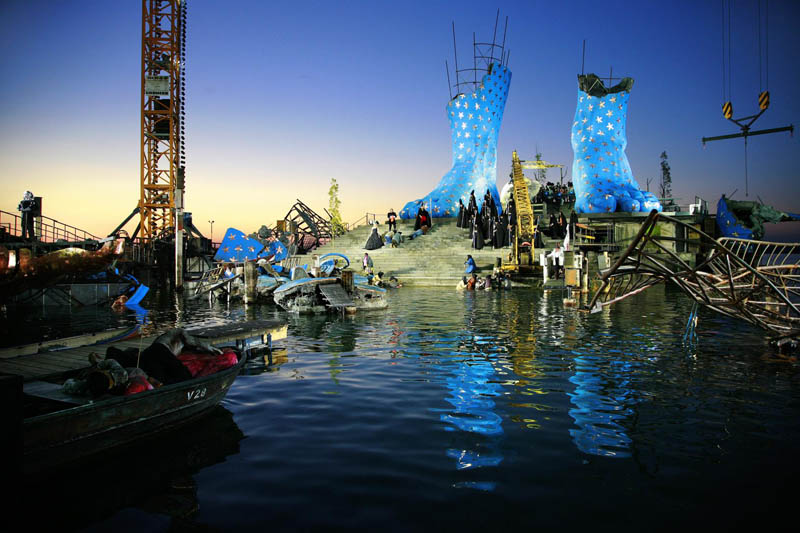
Photograph by Bregenzer Festspiele / andreart
17. André Chénier by Umberto Giordano | 2011-2012
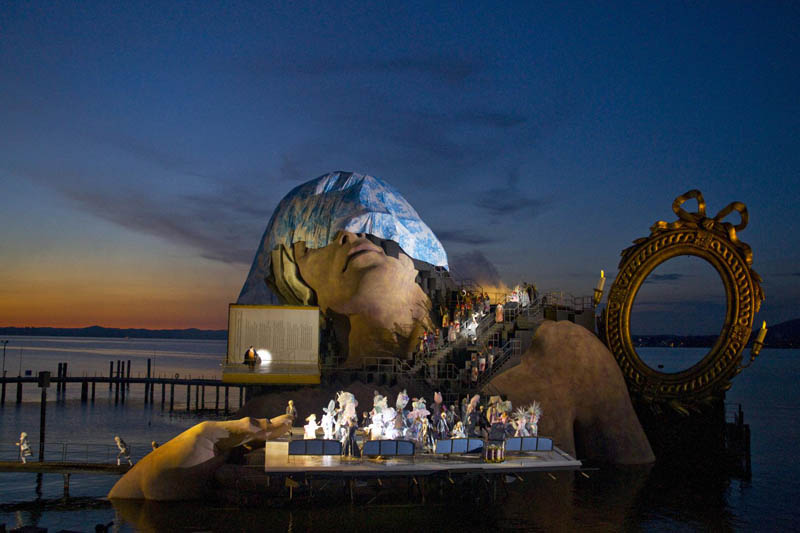
Photograph by KARL FORSTER
18. André Chénier by Umberto Giordano | 2011-2012
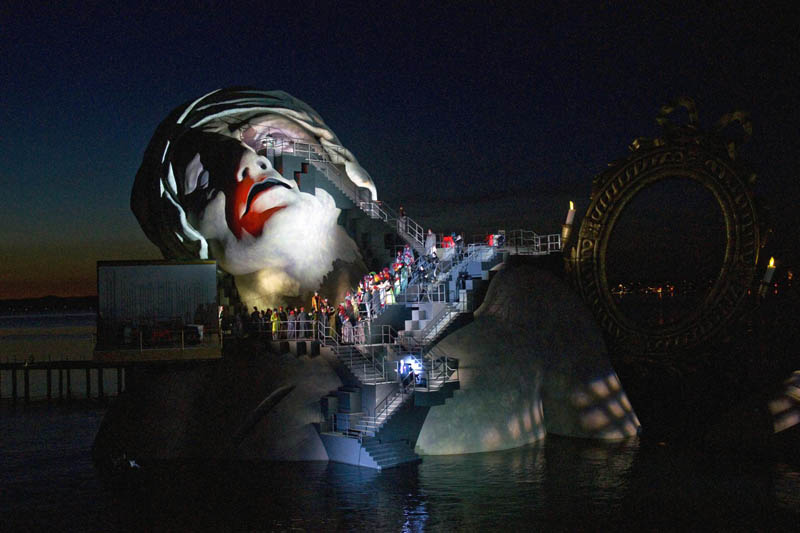
Photograph by KARL FORSTER
19. André Chénier by Umberto Giordano | 2011-2012
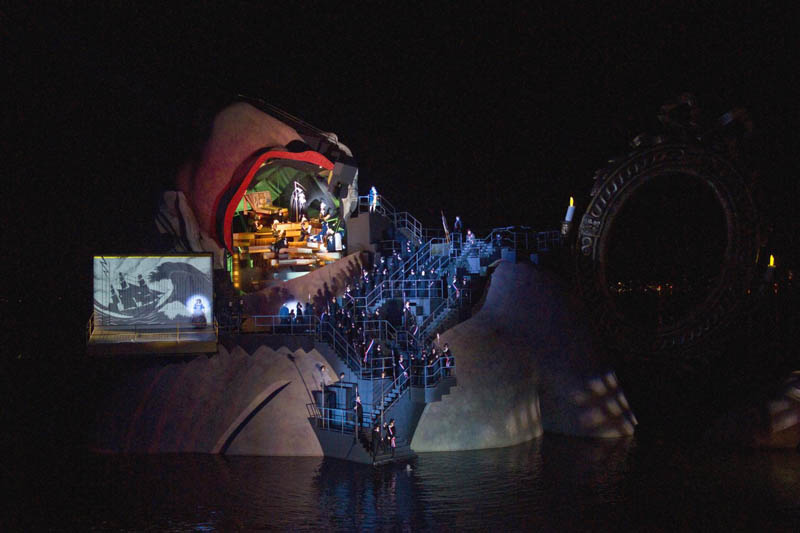
Photograph by KARL FORSTER
20. André Chénier by Umberto Giordano | 2011-2012
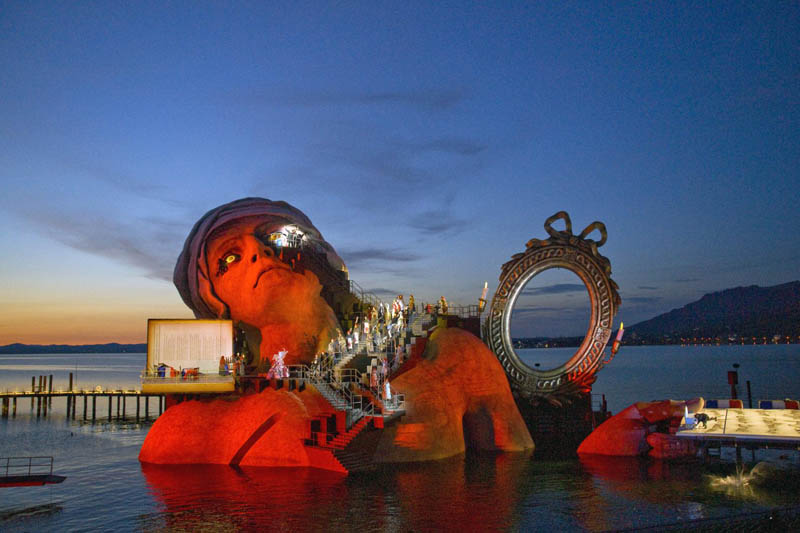
Photograph by KRISTI SAUER

No comments:
Post a Comment
Note: Only a member of this blog may post a comment.